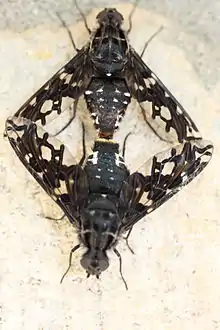Xenox tigrinus
The tiger bee fly, Xenox tigrinus, is an insect of the family Bombyliidae (bee flies) found in the eastern United States and southern Ontario.[1] It formerly went by the name Anthrax tigrinus.[2] The distinctive wing pattern may resemble tiger stripes, giving the tiger bee fly its name. Like other members of the bee fly family, the tiger bee fly parasitizes the larvae of other insects.
| Xenox tigrinus | |
|---|---|
.jpg.webp) | |
| Scientific classification | |
| Kingdom: | Animalia |
| Phylum: | Arthropoda |
| Class: | Insecta |
| Order: | Diptera |
| Family: | Bombyliidae |
| Genus: | Xenox |
| Species: | X. tigrinus |
| Binomial name | |
| Xenox tigrinus Evenhuis, 1984 | |
Identification
Adults range from 11mm to 19mm in length, excluding wings and other appendages including antennae and legs.[3] Their black body has two white spots on the abdomen and their transparent wings have a distinctive black pattern. The tiger bee fly may be mistaken for a large bee due to its coloration and size. Their bee mimicry (an example of Batesian mimicry) helps them avoid potential predators.[4]
Life Cycle

Female tiger bee flies deposit fertilized eggs in carpenter bee nests. Rather than entering the nest itself, female tiger flies lays eggs near the nest entrance.[2] When the larvae hatch, they consume the carpenter bee larvae.[3] The fly larvae may also wait for the bees to enter the vulnerable pupal state before eating them.[5] The tiger bee fly is the most common parasite of the American carpenter bee, Xylocopa virginica.[6] It is also considered a pollinator.[7]
.jpg.webp)
Interaction with Humans
The tiger bee fly is commonly found near wooden fences and structures where carpenter bees make their nests.[4] They do not bite or sting humans.
References
- Ávalos-Hernández, Omar; Kits, Joel; Trujano-Ortega, Marysol; García-Vázquez, Uri; Cano-Santana, Zenon (2014-03-07). "New records of bee flies (Diptera, Bombyliidae) from Cuatro Ciénegas, Coahuila, Mexico". ZooKeys. 422: 49–85. doi:10.3897/zookeys.422.7598. ISSN 1313-2970.
- Prager, Sean M. (2014-12-01). "Comparison of social and solitary nesting carpenter bees in sympatry reveals no advantage to social nesting". Biological Journal of the Linnean Society. 113 (4): 998–1010. doi:10.1111/bij.12395. ISSN 0024-4066.
- "Tiger Bee Fly". www.insectidentification.org. Retrieved 2020-08-04.
- "Tiger Bee Fly". MDC Discover Nature. Retrieved 2020-08-04.
- Feinstein, Julie. "The Carpenter Bee and the Tiger Bee Fly". Retrieved 2020-08-04.
- Prager, Sean M.; Hunter, Fiona F. (2011-03-12). "Relationships between Nest Architecture and Behavior in Xylocopa virginica (Hymenoptera: Apidae)". Journal of Insect Behavior. 24 (4): 293–306. doi:10.1007/s10905-011-9256-x. ISSN 0892-7553.
- Cusser, Sarah (2016). "Understanding land-use drivers of pollinator community composition in an agricultural lanscape [sic]". 2016 International Congress of Entomology. Entomological Society of America. doi:10.1603/ice.2016.94635.